An Analysis of Electromagnetic Disturbances from an Electric Vehicle Charging Station
Abstract
:1. Introduction
- 31,633 EVs (15,255 battery EVs and 16,376 plug-in hybrid EVs), and
- 1675 public charging points (1159 AC type and 516 DC type).
2. Materials and Methods
2.1. Harmonic Current Emission Measurements
2.2. Measurements of Conductive Electromagnetic Disturbances
3. Results and Discussion
3.1. Harmonic Current Emissions
3.2. Conductive Electromagnetic Emissions
4. Conclusions
Author Contributions
Funding
Institutional Review Board Statement
Informed Consent Statement
Acknowledgments
Conflicts of Interest
References
- Tucki, K.; Orynycz, O.; Świć, A.; Mitoraj-Wojtanek, M. The Development of Electromobility in Poland and EU States as a Tool for Management of CO2 Emissions. Energies 2019, 12, 2942. [Google Scholar] [CrossRef] [Green Version]
- Polish Ministry of Energy. Electromobility Development Plan in Poland “Energy for the Future”; Polish Ministry of Energy: Warsaw, Poland, 2017.
- Johansson, S.; Persson, J.; Lazarou, S.; Theocharis, A. Investigation of the Impact of Large-Scale Integration of Electric Vehicles for a Swedish Distribution Network. Energies 2019, 12, 4717. [Google Scholar] [CrossRef] [Green Version]
- Li, W.; Lin, Z.; Cai, K.; Zhou, H.; Yan, G. Multi-Objective Optimal Charging Control of Plug-In Hybrid Electric Vehicles in Power Distribution Systems. Energies 2019, 12, 2563. [Google Scholar] [CrossRef] [Green Version]
- International Energy Agency. Global EV Outlook 2021. Accelerating Ambitions despite the Pandemic; International Energy Agency: Paris, France, 2021. [Google Scholar]
- Global EV Data Explorer. Available online: https://www.iea.org/articles/global-ev-data-explorer (accessed on 4 November 2021).
- International Energy Agency. Global EV Outlook 2020; International Energy Agency: Paris, France, 2020. [Google Scholar]
- Polski Licznik Elektromobilności. Available online: https://pspa.com.pl/ (accessed on 4 November 2021).
- The National Fund for Environmental Protection and Water Management Will Co-Finance the Purchase of Electric Vehicles. Available online: https://www.gov.pl/web/climate/the-national-fund-for-environmental-protection-and-water-management-will-co-finance-the-purchase-of-electric-vehicles (accessed on 10 October 2021).
- Dotacje Do Aut Elektrycznych Okazały Się Klapą. Available online: https://moto.rp.pl/tu-i-teraz/46109-dotacje-do-aut-elektrycznych-okazaly-sie-klapa (accessed on 15 October 2021).
- Kaushal, J.; Basak, P. Power quality control based on voltage sag/swell, unbalancing, frequency, THD and power factor using artificial neural network in PV integrated AC microgrid. Sustain. Energy Grids Netw. 2020, 23, 100365. [Google Scholar] [CrossRef]
- Nömm, J.; Rönnberg, S.; Bollen, M. An Analysis of Voltage Quality in a Nanogrid during Islanded Operation. Energies 2019, 12, 614. [Google Scholar] [CrossRef] [Green Version]
- Mazurek, P. Chosen Aspects of the Electromagnetic Compatibility of Plasma Reactors with Gliding Arc Discharges. Appl. Sci. 2020, 10, 3789. [Google Scholar] [CrossRef]
- Wannous, K.; Toman, P. Evaluation of Harmonics Impact on Digital Relays. Energies 2018, 11, 893. [Google Scholar] [CrossRef] [Green Version]
- Al-Saadi, M.; Patkowski, B.; Zaremba, M.; Karwat, A.; Pol, M.; Chełchowski, Ł.; Mierlo, J.V.; Berecibar, M. Slow and Fast Charging Solutions for Li-Ion Batteries of Electric Heavy-Duty Vehicles with Fleet Management Strategies. Sustainability 2021, 13, 639. [Google Scholar] [CrossRef]
- Awadallah, M.A.; Singh, B.N.; Venkatesh, B. Impact of EV Charger Load on Distribution Network Capacity: A Case Study in Toronto. Can. J. Electr. Comput. Eng. 2016, 39, 268–273. [Google Scholar] [CrossRef]
- Lucas, A.; Trentadue, G.; Scholz, H.; Otura, M. Power Quality Performance of Fast-Charging under Extreme Temperature Conditions. Energies 2018, 11, 2635. [Google Scholar] [CrossRef] [Green Version]
- Richardson, P.; Flynn, D.; Keane, A. Impact assessment of varying penetrations of electric vehicles on low voltage distribution systems. In Proceedings of the IEEE PES General Meeting, Minneapolis, MN, USA, 25–29 July 2010; pp. 1–6. [Google Scholar]
- Zagrajek, K.; Paska, J.; Kłos, M.; Pawlak, K.; Marchel, P.; Bartecka, M.; Michalski, Ł.; Terlikowski, P. Impact of Electric Bus Charging on Distribution Substation and Local Grid in Warsaw. Energies 2020, 13, 1210. [Google Scholar] [CrossRef] [Green Version]
- Wang, J.; Cui, Y.; Zhu, M. Probabilistic Harmonic Calculation in Distribution Networks with Electric Vehicle Charging Stations. J. Appl. Math. 2014, 2014, 167565. [Google Scholar] [CrossRef]
- Zhang, Y.; Yu, D.; Zhang, G.; Wang, H.; Zhuang, J. Harmonic Analysis of EV Charging Station Based on Measured Data. In Proceedings of the 2020 IEEE/IAS Industrial and Commercial Power System Asia (I&CPS Asia), Weihai, China, 13–16 July 2020; pp. 475–480. [Google Scholar]
- Alame, D.; Azzouz, M.; Kar, N. Assessing and Mitigating Impacts of Electric Vehicle Harmonic Currents on Distribution Systems. Energies 2020, 13, 3257. [Google Scholar] [CrossRef]
- Bass, R.; Zimmerman, N. Impacts of Electric Vehicle Charging on Electric Power Distribution Systems; Transportation Research and Education Center (TREC): Portland, OR, USA, 2013. [Google Scholar]
- Melo, N.; Mira, F.; de Almeida, A.; Delgado, J. Integration of PEV in Portuguese distribution grid: Analysis of harmonic current emissions in charging points. In Proceedings of the 11th International Conference on Electrical Power Quality and Utilisation, Lisbon, Portugal, 17–19 October 2011; pp. 1–6. [Google Scholar]
- Bhajana, V.V.S.K.; Jarzyna, W.; Fatyga, K.; Zielinski, D.; Kwaśny, L. Performance of a SiC MOSFET based isolated dual active bridge dc-dc converter for electro-mobility applications. Rev. Roum. Sci. Tech. Ser. Électrotech. Énergétique 2019, 64, 383–390. [Google Scholar]
- van der Burgt, J.; Vera, S.P.; Wille-Haussmann, B.; Andersen, A.N.; Tambjerg, L.H. Grid impact of charging electric vehicles; study cases in Denmark, Germany and The Netherlands. In Proceedings of the 2015 IEEE Eindhoven PowerTech, Eindhoven, The Netherlands, 29 June–2 July 2015; pp. 1–6. [Google Scholar]
- Lucas, A.; Bonavitacola, F.; Kotsakis, E.; Fulli, G. Grid harmonic impact of multiple electric vehicle fast charging. Electr. Power Syst. Res. 2015, 127, 13–21. [Google Scholar] [CrossRef]
- Batorowicz, D.S.; Zimmer, H.; Franz, P.; Hanson, J. Impact of Battery Charging of Electric Vehicles on Power Quality in Smart Homes and Low-Voltage Distribution Networks. In Proceedings of the International Conference on Renewable Energies and Power Quality, Madrid, Spain, 4–6 May 2016. [Google Scholar]
- Un-Noor, F.; Padmanaban, S.; Mihet-Popa, L.; Mollah, M.; Hossain, E. A Comprehensive Study of Key Electric Vehicle (EV) Components, Technologies, Challenges, Impacts, and Future Direction of Development. Energies 2017, 10, 1217. [Google Scholar] [CrossRef] [Green Version]
- Dharmakeerthi, C.; Mithulananthan, N.; Saha, T.K. Overview of the impacts of plug-in electric vehicles on the power grid. In Proceedings of the 2011 IEEE PES Innovative Smart Grid Technologies, Perth, Australia, 13–16 November 2011; pp. 1–8. [Google Scholar]
- Wang, L.; Qin, Z.; Slangen, T.; Bauer, P.; van Wijk, T. Grid Impact of Electric Vehicle Fast Charging Stations: Trends, Standards, Issues and Mitigation Measures—An Overview. IEEE Open J. Power Electron. 2021, 2, 56–74. [Google Scholar] [CrossRef]
- Pieltain Fernandez, L.; Gomez San Roman, T.; Cossent, R.; Mateo Domingo, C.; Frias, P. Assessment of the Impact of Plug-in Electric Vehicles on Distribution Networks. IEEE Trans. Power Syst. 2011, 26, 206–213. [Google Scholar] [CrossRef]
- Pillai, J.R.; Bak-Jensen, B. Impacts of electric vehicle loads on power distribution systems. In Proceedings of the 2010 IEEE Vehicle Power and Propulsion Conference, Lille, France, 1–3 September 2010; pp. 1–6. [Google Scholar]
- Masoum, M.A.; Moses, P.S.; Smedley, K.M. Distribution transformer losses and performance in smart grids with residential plug-in electric vehicles. In Proceedings of the ISGT 2011, Anaheim, CA, USA, 17–19 January 2011; pp. 1–7. [Google Scholar]
- Deilami, S.; Masoum, A.S.; Moses, P.S.; Masoum, M.A.S. Voltage profile and THD distortion of residential network with high penetration of Plug-in Electrical Vehicles. In Proceedings of the 2010 IEEE PES Innovative Smart Grid Technologies Conference Europe (ISGT Europe), Gothenburg, Sweden, 11–13 October 2010; pp. 1–6. [Google Scholar]
- Slangen, T.; van Wijk, T.; Ćuk, V.; Cobben, S. The Propagation and Interaction of Supraharmonics from Electric Vehicle Chargers in a Low-Voltage Grid. Energies 2020, 13, 3865. [Google Scholar] [CrossRef]
- Chudy, A.; Stryczewska, H.D. Electromagnetic Compatibility Testing of Electric Vehicles and Their Chargers. Inform. Autom. Pomiary Gospod. Ochr. Sr. 2020, 10, 70–73. [Google Scholar] [CrossRef]
- Chudy, A.; Mazurek, P. Electromobility—The Importance of Power Quality and Environmental Sustainability. J. Ecol. Eng. 2019, 20, 15–23. [Google Scholar] [CrossRef]
- Baraniak, J.; Starzyński, J. Modeling the Impact of Electric Vehicle Charging Systems on Electric Power Quality. Energies 2020, 13, 3951. [Google Scholar] [CrossRef]
- Liang, Z.; Chen, H.; Wang, X.; Chen, S.; Zhang, C. Risk-Based Uncertainty Set Optimization Method for Energy Management of Hybrid AC/DC Microgrids With Uncertain Renewable Generation. IEEE Trans. Smart Grid 2020, 11, 1526–1542. [Google Scholar] [CrossRef]
- Watson, N.; Watson, R.; Paterson, T.; Russell, G.; Ellerington, M.; Langella, R. Power Quality of a bidirectional Electric Vehicle charger. In Proceedings of the 2020 19th International Conference on Harmonics and Quality of Power (ICHQP), Dubai, United Arab Emirates, 6–7 July 2020; pp. 1–5. [Google Scholar]
- Das, H.S.; Rahman, M.M.; Li, S.; Tan, C.W. Electric vehicles standards, charging infrastructure, and impact on grid integration: A technological review. Renew. Sustain. Energy Rev. 2020, 120, 109618. [Google Scholar] [CrossRef]
- Iqbal, M.N.; Kütt, L.; Asad, B.; Vaimann, T.; Rassõlkin, A.; Demidova, G.L. Time Dependency of Current Harmonics for Switch-Mode Power Supplies. Appl. Sci. 2020, 10, 7806. [Google Scholar] [CrossRef]
- Fatyga, K.; Zieliński, D. Comparison of main control strategies for DC/DC stage of bidirectional vehicle charger. In Proceedings of the 2017 International Symposium on Electrical Machines (SME), Naleczow, Poland, 18–21 June 2017; pp. 1–4. [Google Scholar]
- Zieliński, D.; Fatyga, K. Dual Active Bridge as a DC Link Current Pulsation Compensator in Energy Storage Applications. Energies 2021, 14, 6141. [Google Scholar] [CrossRef]
- Jarzyna, W.; Zieliński, D.; Gopakumar, K. An evaluation of the accuracy of inverter sync angle during the grid’s disturbances. Metrol. Meas. Syst. 2020, 27, 355–371. [Google Scholar]
- Shen, Y.; Abubakar, M.; Liu, H.; Hussain, F. Power Quality Disturbance Monitoring and Classification Based on Improved PCA and Convolution Neural Network for Wind-Grid Distribution Systems. Energies 2019, 12, 1280. [Google Scholar] [CrossRef] [Green Version]
- Castello, P.; Muscas, C.; Pegoraro, P.; Sulis, S. PMU’s Behavior with Flicker-Generating Voltage Fluctuations: An Experimental Analysis. Energies 2019, 12, 3355. [Google Scholar] [CrossRef] [Green Version]
- Tariq, M.; Adnan, M. Stabilizing super smart grids using v2g: A probabilistic analysis. In Proceedings of the 2019 IEEE 89th Vehicular Technology Conference (VTC2019-Spring), Kuala Lumpur, Malaysia, 28 April–1 May 2019; pp. 1–5. [Google Scholar]
- Deb, S.; Tammi, K.; Kalita, K.; Mahanta, P. Impact of Electric Vehicle Charging Station Load on Distribution Network. Energies 2018, 11, 178. [Google Scholar] [CrossRef] [Green Version]
- Ding, T.; Chen, H.; Wu, B.; Hu, P. Harmonic characteristics analysis of PWM-based electric vehicle chargers considering control strategy. In Proceedings of the 2018 18th International Conference on Harmonics and Quality of Power (ICHQP), Ljubljana, Slovenia, 13–16 May 2018; pp. 1–5. [Google Scholar]
- Arranz-Gimon, A.; Zorita-Lamadrid, A.; Morinigo-Sotelo, D.; Duque-Perez, O. A Review of Total Harmonic Distortion Factors for the Measurement of Harmonic and Interharmonic Pollution in Modern Power Systems. Energies 2021, 14, 6467. [Google Scholar] [CrossRef]
- Michalec, Ł.; Jasiński, M.; Sikorski, T.; Leonowicz, Z.; Jasiński, Ł.; Suresh, V. Impact of Harmonic Currents of Nonlinear Loads on Power Quality of a Low Voltage Network–Review and Case Study. Energies 2021, 14, 3665. [Google Scholar] [CrossRef]
- Zheng, Y.; Niu, S.; Shang, Y.; Shao, Z.; Jian, L. Integrating plug-in electric vehicles into power grids: A comprehensive review on power interaction mode, scheduling methodology and mathematical foundation. Renew. Sustain. Energy Rev. 2019, 112, 424–439. [Google Scholar] [CrossRef]
- Christidis, P.; Focas, C. Factors Affecting the Uptake of Hybrid and Electric Vehicles in the European Union. Energies 2019, 12, 3414. [Google Scholar] [CrossRef] [Green Version]
- International Electrotechnical Commission. Electromagnetic Compatibility (EMC)—Part 3-12: Limits—Limits for Harmonic Currents Produced by Equipment Connected to Public Low-Voltage Systems with Input Current >16 A and ≤75 A per Phase, 2nd ed.; IEC 61000-3-12; International Electrotechnical Commission: Geneva, Switzerland, 2011. [Google Scholar]
- Li, Z.; Shao, T.; Zheng, T.Q.; Li, H.; Huang, B. Interference source analysis and EMC design for All-SiC power module in EV charger. Microelectron. Reliab. 2019, 100–101, 113458. [Google Scholar] [CrossRef]
- Sandrolini, L.; Thomas, D.W.; Sumner, M.; Rose, C. Measurement and evaluation of the conducted emissions of a DC/DC power converter in the frequency range 2–150 kHz. In Proceedings of the 2018 IEEE Symposium on Electromagnetic Compatibility, Signal Integrity and Power Integrity (EMC, SI & PI), Long Beach, CA, USA, 30 July–3 August 2018; pp. 345–350. [Google Scholar]
- Pliakostathis, K.; Scholz, H. On the Evaluation of Electromagnetic Compatibility (EMC) of a Prototype Electric Vehicle; Publications Office of the European Union: Luxembourg, 2018. [Google Scholar]
- Pliakostathis, K.; Zanni, M.; Trentadue, G.; Scholz, H.; Kluge, D.H.; Frankholz, M.; Sauer, L.; Becker, E.; Weckermann, C.; Demirci, G.; et al. Electromagnetic Compatibility (EMC) Evaluation of a Prototype Solar-Charged Electric Race-Car; Publications Office of the European Union: Luxembourg, 2019. [Google Scholar]
- Pliakostathis, K.; Zanni, M.; Scholz, H.; Trentadue, G. Assessment and Analysis of the Electromagnetic Profile of Prototype High-Power-Charging Units for Electric Vehicles; Publications Office of the European Union: Luxembourg, 2019. [Google Scholar]
- Politechnika Lubelska; PGE Dystrybucja. PLUGinEV—Electric Vehicle Charging System Integrated with Lighting Infrastructure, EU Project POIR.04.01.02-00-0052/16. Available online: http://pluginev.pollub.pl (accessed on 27 October 2021).
- International Electrotechnical Commission. Electromagnetic Compatibility (EMC)—Part 3-2: Limits—Limits for Harmonic Current Emissions (Equipment Input Current ≤16 A per Phase), 4th ed.; IEC 61000-3-2; International Electrotechnical Commission: Geneva, Switzerland, 2014. [Google Scholar]
- International Electrotechnical Commission. Electric Vehicle Conductive Charging System—Part 21-2: Electric Vehicle Requirements for Conductive Connection to an AC/DC Supply—EMC Requirements for off Board Electric Vehicle Charging Systems; IEC 61851-21-2; International Electrotechnical Commission: Geneva, Switzerland, 2018. [Google Scholar]
- Foskolos, G. Measurement-Based Current-Harmonics Modeling of Aggregated Electric-Vehicle Loads Using Power-Exponential Functions. World Electr. Veh. J. 2020, 11, 51. [Google Scholar] [CrossRef]
- Slangen, T.; van Wijk, T.; Ćuk, V.; Cobben, J. The harmonic and supraharmonic emission of battery electric vehicles in the Netherlands. In Proceedings of the 2020 International Conference on Smart Energy Systems and Technologies (SEST), Istanbul, Turkey, 7–9 September 2020; pp. 1–6. [Google Scholar]
- Wu, G.; Xu, B.; Yu, H.; Dong, E. Power quality analysis and harmonic suppression of high latitude and high alpine region electric vehicles charging station. In Proceedings of the 2013 World Electric Vehicle Symposium and Exhibition (EVS27), Barcelona, Spain, 17–20 November 2013; pp. 1–5. [Google Scholar]
- Sabarimuthu, M.; Senthilnathan, N.; Monnisha, A.; KamaleshKumar, V.; Sree, S.K.; Sundari, P.M. Measurement and Analysis of Power Quality Issues Due to Electric Vehicle Charger. In Proceedings of the IOP Conference Series: Materials Science and Engineering, Sanya, China, 12–14 November 2021; p. 012131. [Google Scholar]
- Rahman, S.; Shrestha, G.B. An investigation into the impact of electric vehicle load on the electric utility distribution system. IEEE Trans. Power Deliv. 1993, 8, 591–597. [Google Scholar] [CrossRef]
- Wanik, M.; Siam, M.F.; Ayob, A.; Mohamed, A.; HanifahAzit, A.; Sulaiman, S.; Ali, M.A.M.; Hussein, Z.F.; MatHussin, A.K. Harmonic Measurement and Analysis during Electric Vehicle Charging. Engineering 2013, 5, 215–220. [Google Scholar] [CrossRef]
- Taylor, J.; Maitra, A.; Alexander, M.; Brooks, D.; Duvall, M. Evaluations of plug-in electric vehicle distribution system impacts. In Proceedings of the IEEE PES General Meeting, Minneapolis, MN, USA, 25–29 July 2010; pp. 1–6. [Google Scholar]
- Kim, K.; Song, C.S.; Byeon, G.; Jung, H.; Kim, H.; Jang, G. Power demand and total harmonic distortion analysis for an EV charging station concept utilizing a battery energy storage system. J. Electr. Eng. Technol. 2013, 8, 1234–1242. [Google Scholar] [CrossRef] [Green Version]
- Ćuk, V.; Cobben, J.F.; Kling, W.L.; Ribeiro, P.F. Analysis of harmonic current summation based on field measurements. IET Gener. Transm. Distrib. 2013, 7, 1391–1400. [Google Scholar] [CrossRef]


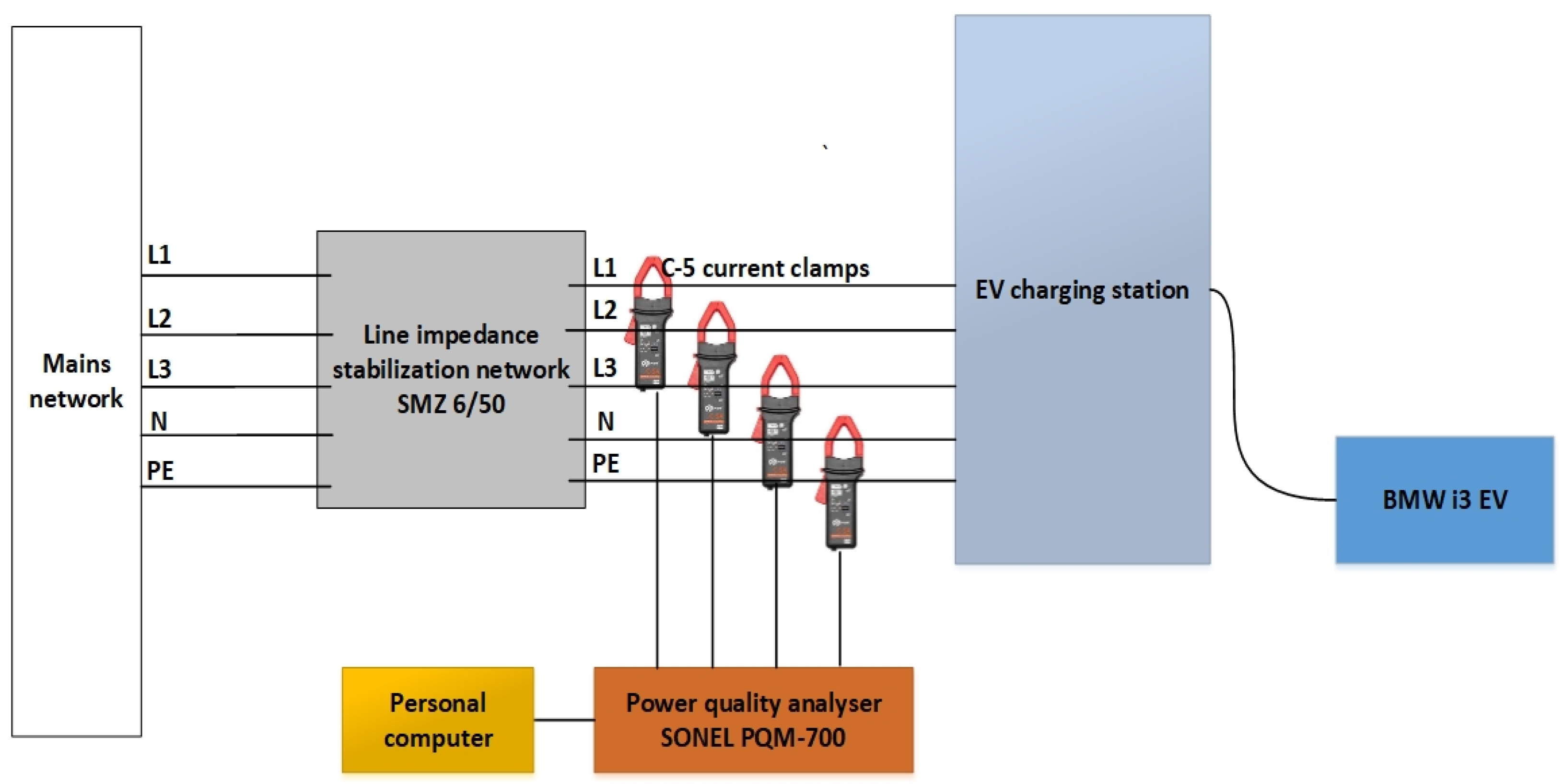
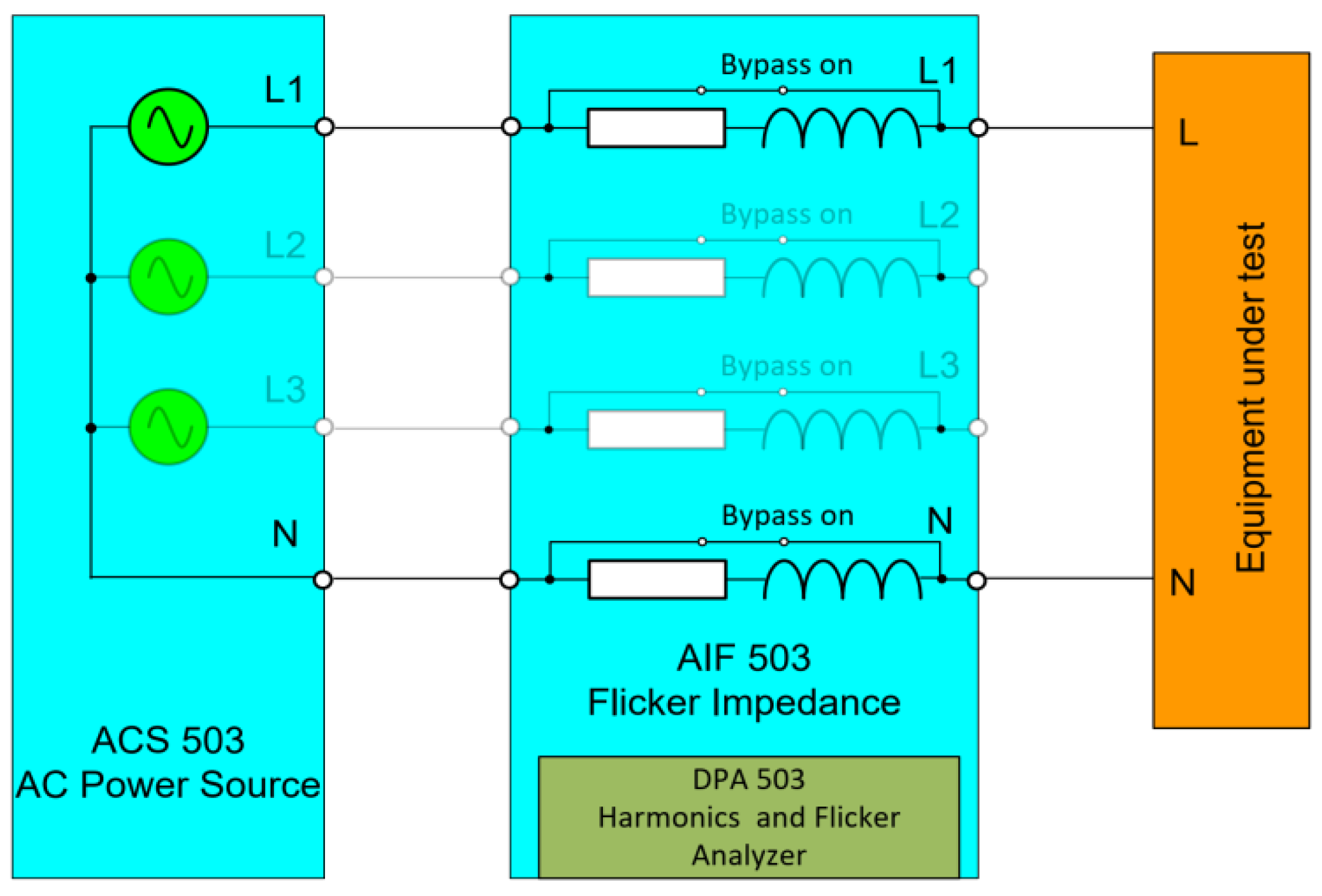

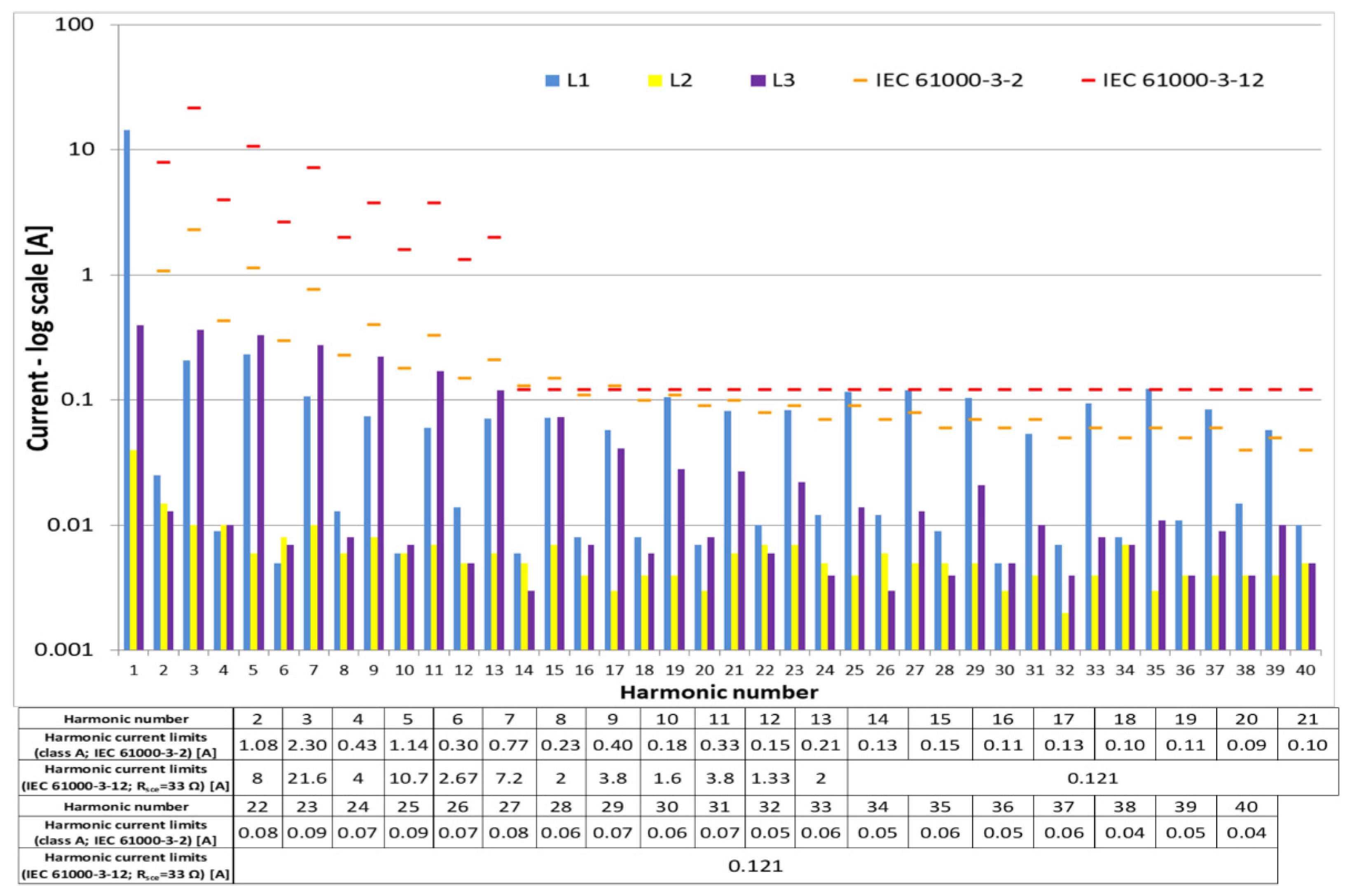


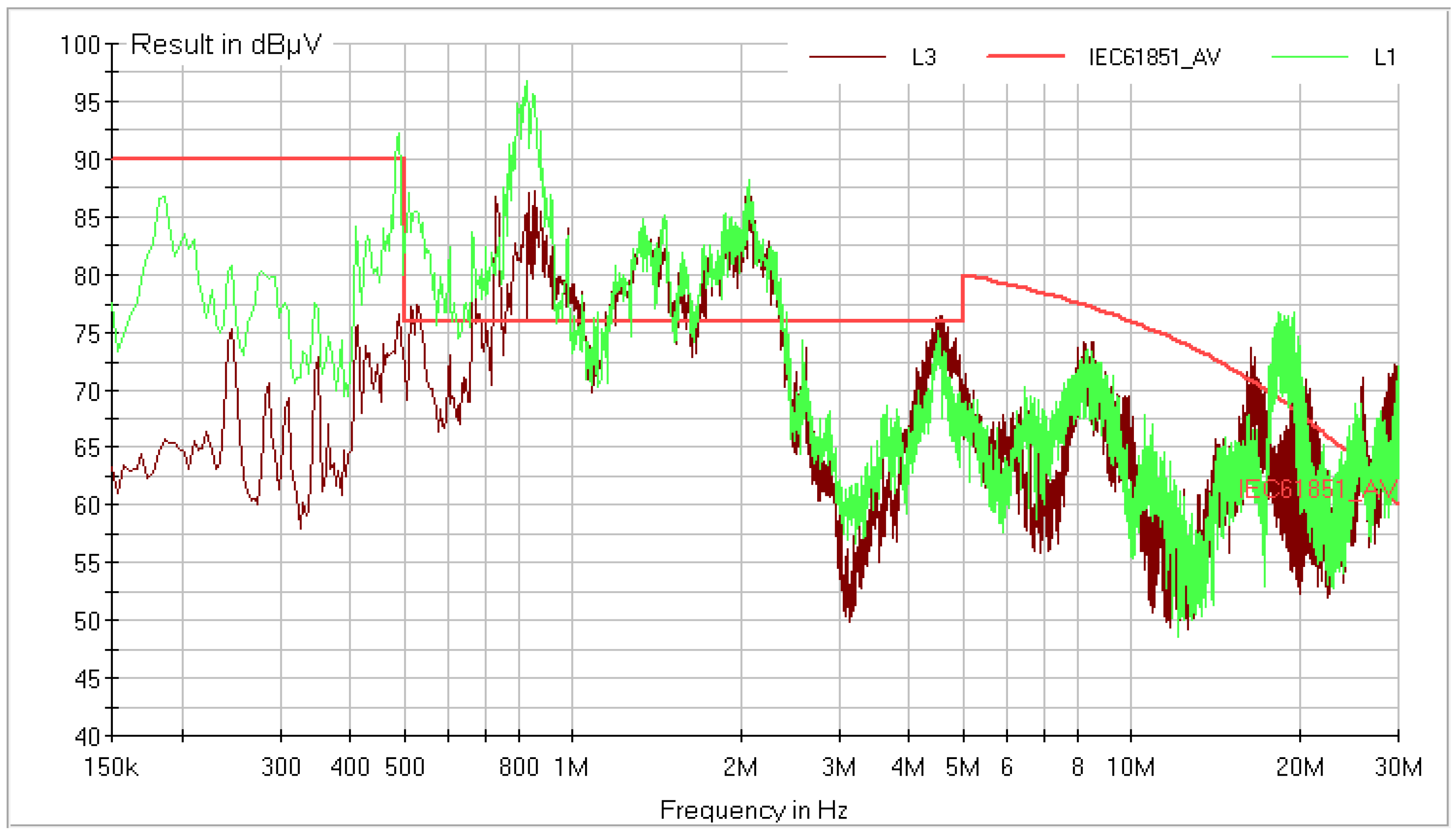

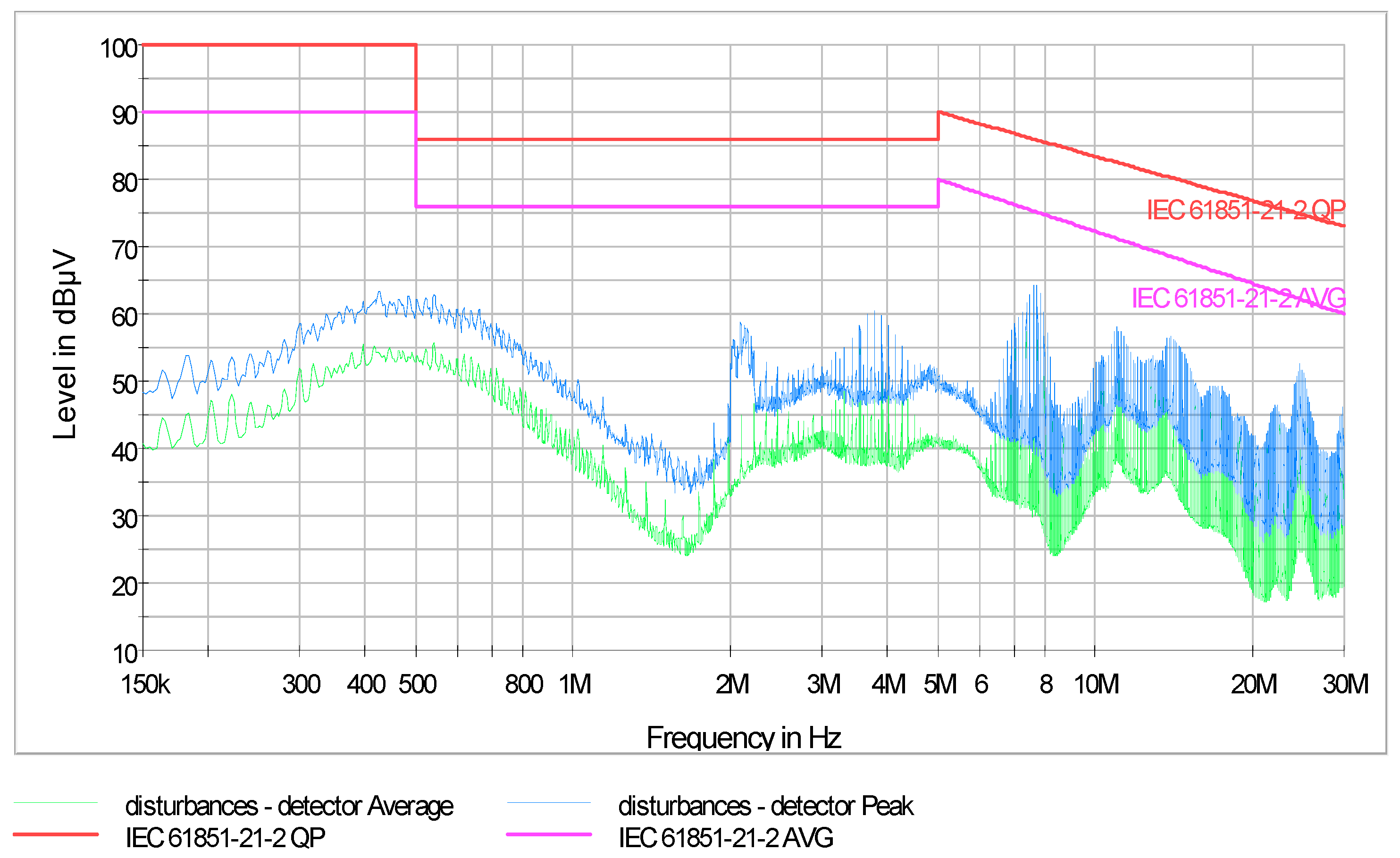
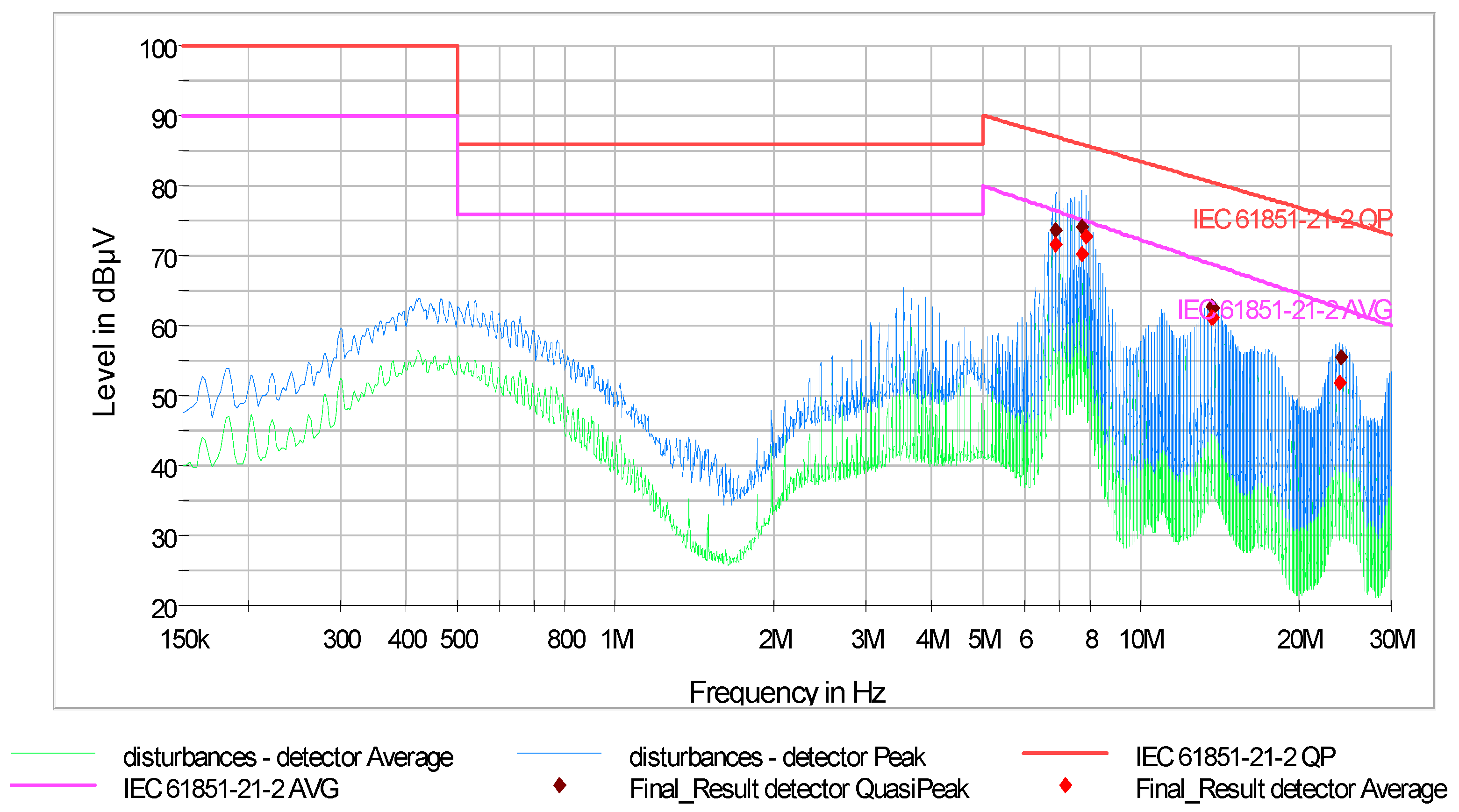
| Phase | THDI during BMW i3 Charging | THDI of the AC Module | THDI of the DC Module |
|---|---|---|---|
| L1 | 3.37% | 0.29% | 4.43% |
| L2 | - 1 | 0.17% | 4.13% |
| L3 | - 1 | 1.98% | 4.61% |
Publisher’s Note: MDPI stays neutral with regard to jurisdictional claims in published maps and institutional affiliations. |
© 2021 by the authors. Licensee MDPI, Basel, Switzerland. This article is an open access article distributed under the terms and conditions of the Creative Commons Attribution (CC BY) license (https://creativecommons.org/licenses/by/4.0/).
Share and Cite
Mazurek, P.; Chudy, A. An Analysis of Electromagnetic Disturbances from an Electric Vehicle Charging Station. Energies 2022, 15, 244. https://doi.org/10.3390/en15010244
Mazurek P, Chudy A. An Analysis of Electromagnetic Disturbances from an Electric Vehicle Charging Station. Energies. 2022; 15(1):244. https://doi.org/10.3390/en15010244
Chicago/Turabian StyleMazurek, Paweł, and Aleksander Chudy. 2022. "An Analysis of Electromagnetic Disturbances from an Electric Vehicle Charging Station" Energies 15, no. 1: 244. https://doi.org/10.3390/en15010244
APA StyleMazurek, P., & Chudy, A. (2022). An Analysis of Electromagnetic Disturbances from an Electric Vehicle Charging Station. Energies, 15(1), 244. https://doi.org/10.3390/en15010244






